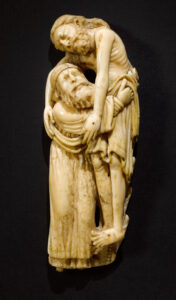
The Romanesque carving was made between 1190 and 1200 probably in York. It was originally part of a much larger altarpiece of scenes from the Passion of the Christ. The carved details — the drapery, poses, the facial expressions — are masterful examples of skill in ivory carving. The English Reformation slashed and burned much of this kind of devotional art. Today the Deposition is widely considered one of the greatest surviving pieces of medieval British carved ivory.
Because of its great rarity, the exceptional quality of the carving and its cultural significance, the UK Arts Minister placed a temporary export bar on the Deposition to allow a local museum the opportunity to match the purchase price and keep the artwork in Britain. There was no question as to which local museum would throw its hat in the ring. The Deposition and a fragment depicting Judas at the Last Supper from the same lost altarpiece were on display together at the V&A from 1982 until 2022. The Judas fragment was donated to the museum in 1949; the Deposition was on long-term loan from collectors John and Gertrude Hunt, and only left the museum when their heirs decided to sell it.

As soon as the temporary export ban was in place, the V&A launched a fundraising campaign to raise the large sum. Two grants (£700,000 from the National Heritage Memorial Fund and £350,000 from the Art Fund) got them more than halfway to the goal. Other non-profits, the museum’s own budget and donors near and far got the V&A to its goal.
Light conservation is now being conducted on the Deposition and it will go on display in September. It will be shown alongside the Judas fragment, in the V&A’s Medieval and Renaissance galleries.
* This article was originally published here








No comments:
Post a Comment